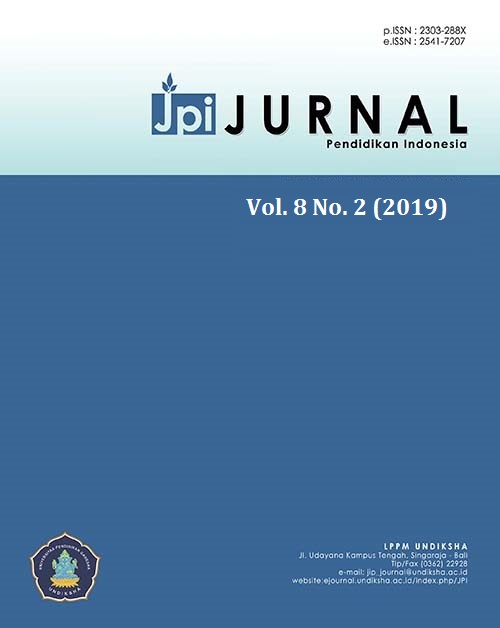The Conceptual and Hypothetical Model of Interactive Blended Problem Based Learning
DOI:
https://doi.org/10.23887/jpi-undiksha.v8i2.24162Keywords:
Instructional Model Development, Blended Learning, Problem-Based Learning, Interactive, Programming LanguageAbstract
This article discusses the results of research on the development of conceptual models and hypothetical models of Interactive Blended Problem Based Learning (IBPBL) in Programming Language subjects for Electrical Engineering students at Universitas Negeri Padang. This model is a blended learning model that combines face-to-face learning in class and Moodle-based online learning with problem-based learning syntax in the field of Electrical Engineering. The research was carried out in three stages: (1) literature review, (2) formulation of the conceptual model, and (3) formulation of the hypothetical model. The IBPBL conceptual models consist of: (1) philosophical components: pragmatism; (2) theoretical components: cognitivism, behaviorism, constructivism, and connectivism; (3) methodological components: problem-based learning; and (4) technical components: problem-solving, cooperation, critical thinking, innovative, creative and systematic. The hypothetical model is based on students' ability to solve problems critically, creatively, collaboratively, systematically by utilizing the various advantages possessed by face-to-face and online learning in Programming Language courses. Model validation is done using expert judgment. The expert assessment assessed the IBPBL model in three aspects, namely: (1) component sufficiency, (2) content, and (3) ease of implementation.
References
Donnelly, R. (2006). Blended problem-based learning for teacher education: Lessons learnt. Learning, Media and Technology. https://doi.org/10.1080/17439880600756621
Drissi, S., & Amirat, A. (2016). An experimental study to evaluate learning style personalisation in web-based adaptive e-learning systems. International Journal of Innovation and Learning. https://doi.org/10.1504/IJIL.2016.076669
Effendi, H., & Hendriyani, Y. (2017a). The Develoment Of Interactive Blended Problem Based Learning Model For Programming Subject. 4th ICTVET, 277–282. https://doi.org/10.31227/OSF.IO/VFMNY
Effendi, H., & Hendriyani, Y. (2017b). The effectiveness of web-based interactive blended learning model in programming language courses. In A. Setiawan, M. B. A. Alias, A. Gafar, & T. Aryanti (Eds.), Regionalization and Harmonization in TVET: Proceedings of the 4th UPI International Conference on Technical and Vocational Education and Training (TVET 2016), November 15-16, 2016, Bandung, Indonesia (pp. 175–178). https://doi.org/110.1201/9781315166568-42
Ertmer, P. A., & Newby, T. J. (1993). Behaviorism, Cognitivism, Constructivism: Comparing Critical Features from an Instructional Design Perspective. Performance Improvement Quarterly. https://doi.org/10.1111/j.1937-8327.1993.tb00605.x
Gall, M. D., Gall, J. P., & Borg, W. R. (2003). Educational Research: An Introduction. Educational Research: An Introduction. Retrieved from http://psycnet.apa.org/psycinfo/1996-97171-000
Graham, C. R. (2011). Blended Learning Models. In Encyclopedia of Information Science and Technology, Second Edition. https://doi.org/10.4018/978-1-60566-026-4.ch063
Idaho Digital Learning. (2014). 6 Models of Blended Learning. 6 Models of Blended Learning.
Jordan, A., Carlile, O., & Stack, A. (2008). Approaches to learning: A guide for teachers. In British Journal of Educational Technology.
Learning theories: A to Z. (2003). Choice Reviews Online. https://doi.org/10.5860/choice.41-0068
Macdonald, D., & Isaacs, G. (2001). Developing a professional identity through problem-based learning. Teaching Education. https://doi.org/10.1080/10476210120096579
Mawardi Effendi, Z., Effendi, H., & Effendi, H. (2017). The role of locus control and learning styles in the development of the blended learning model at PSU. International Journal of GEOMATE, 13(7), 75–80. https://doi.org/10.21660/2017.37.TVET025
Melvin D, M. (2014). Principles and a Philosophy for Vocational Education. Igarss 2014. https://doi.org/10.1007/s13398-014-0173-7.2
Moeller, S., Spitzer, K., & Spreckelsen, C. (2010). How to configure blended problem based learning results of a randomized trial. Medical Teacher. https://doi.org/10.3109/0142159X.2010.490860
Naismith, L., Lonsdale, P., Vavoula, G., & Sharples, M. (2004). Report 11: literature Review in mobile technologies and learning. A report for NESTA Futurelab. University of Birmingham.Retrieved February.
Sadia, I, W. (2014). Model-model pembelajaran sains konstruktivistik. Yogyakarta: Graha Ilmu.
Savin-Baden, M. (2006). The challenge of using problem-based learning online. In Problem-based Learning Online. https://doi.org/10.4324/9780203095959
Schunk, D. H. (2012). Learning theories: An educational perspective. In Reading.
Siemens, G. (2005). Connectivism: A learning theory for the digital age. International Journal of Instructional Technology and Distance Learning.
Downloads
Published
Issue
Section
License
Authors who publish with the Jurnal Pendidikan Indnesia agree to the following terms:
- Authors retain copyright and grant the journal the right of first publication with the work simultaneously licensed under a Creative Commons Attribution License (CC BY-SA 4.0) that allows others to share the work with an acknowledgment of the work's authorship and initial publication in this journal.
- Authors are able to enter into separate, additional contractual arrangements for the non-exclusive distribution of the journal's published version of the work (e.g., post it to an institutional repository or publish it in a book), with an acknowledgment of its initial publication in this journal.
- Authors are permitted and encouraged to post their work online (e.g., in institutional repositories or on their website) prior to and during the submission process, as it can lead to productive exchanges, as well as earlier and greater citation of published work. (See The Effect of Open Access)








